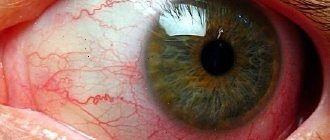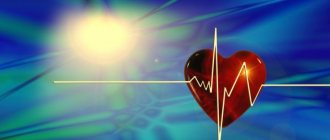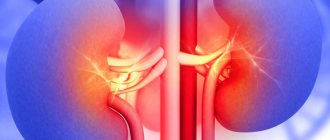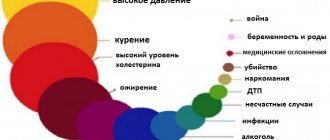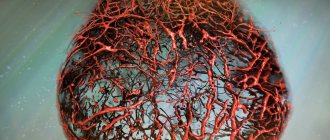Narrowing of the lumen of the right or left renal artery is called stenosis. Bilateral damage is also possible. Clinical manifestations are caused by ischemia of the renal tissue. The main signs are severe arterial hypertension and nephropathy. For treatment, medications are used, as well as surgical methods - plastic surgery, installation of a stent or shunt, removal of the inner lining of the artery.
Why does stenosis of the right and left renal arteries occur, bilateral
The vast majority of patients (about 70%) have atherosclerosis as the main etiological factor. It affects men over 50 years of age much more often than women. The typical location of an atherosclerotic plaque is a branch from the aorta. Background conditions preceding stenosis are: hypertension and ischemic disease, diabetes mellitus.
Congenital thickening of the layers of the arteries is diagnosed, as a rule, in women after 35 years of age. The place of narrowing in these cases is located in the middle segments. The enlargement may affect the inner or middle tunic of one, but more often both, renal arteries.
Less common causes include:
- aortic aneurysm or coarctation;
- arteriovenous connection (developmental anomaly);
- Takayasu syndrome;
- systemic vasculitis;
- blockage of an artery by a thrombus, embolus;
- pressure on the tumor vessel;
- kidney prolapse.
Aortic aneurysm is one of the causes of renal artery stenosis.
Lack of blood flow contributes to the activation of the renin-angiotensin-aldosterone system. This leads to persistent arterial hypertension.
We recommend reading the article on the treatment of renal hypertension. From it you will learn about the danger of the disease and its diagnosis, treatment methods and possible complications.
And here is more information about secondary hypertension.
Manifestation of symptoms
Renal artery stenosis is characterized by two main symptoms - arterial hypertension and ischemic nephropathy.
Due to disturbances in the functioning of the cardiovascular system, the heart rate increases, a feeling of pressure behind the chest occurs, and shortness of breath appears. Patients may also experience constant back pain, hematuria, and seizures.
The disease goes through several stages in its development, each of which is characterized by its own symptoms.
- The initial stage is characterized by the preservation of kidney function; the patient exhibits normotension or moderate arterial hypertension, which can be corrected with medications.
- The subcompensation stage is manifested by impaired renal function, arterial hypertension manifests itself stably. The urinary organs themselves may decrease slightly in size.
- Decompensation - pronounced renal failure manifests itself, arterial hypertension becomes steadily severe, difficult to treat, the paired organ can decrease in size by up to 4 cm.
- Terminal stage - hypertension becomes malignant, blood pressure reaches 250-280 units and does not respond to drug therapy. The organ does not perform its functions, the size may decrease by more than 5 cm.
Chronic renal failure becomes the final stage of the disease, the patient experiences constant symptoms of intoxication of the body - nausea and vomiting, headache, swelling. Such patients are susceptible to frequent pneumonia and inflammation of the abdominal cavity.
Symptoms of the onset of the disease
When initially detecting high blood pressure, it is always necessary to exclude its renal origin, including arterial origin. The main feature of such hypertension is usually high numbers of lower (diastolic) pressure. It can increase to 140 - 160 mm Hg. Art. the norm is 90. Renal hypertension rarely causes crises and has a weak response to antihypertensive drugs.
With high blood pressure, patients report the following symptoms:
- pain in the back of the head, eyeballs, heaviness in the head;
- hot flashes;
- noise in ears;
- sleep disturbance, irritability, increased fatigue;
- flashing dots or spots before the eyes;
- increased heart rate;
- dyspnea;
- cardialgia, pressure behind the sternum;
- pulmonary edema with a recurrent course in severe pathology.
Hypertension can be malignant; it is characterized by a lightning-fast onset and a very rapid increase, progression of renal failure, tissue shrinkage of 5 cm or more.
With a gradual increase in pressure, the following stages of the disease are noted:
- Compensation is a moderate increase, reduced by medications, the kidneys function normally.
- Relative compensation is constantly increased blood pressure, decreased filtering capacity of the kidneys, and a decrease in their size.
- Decompensation – severe hypertension, not relieved by medications, renal failure, wrinkled kidneys.
For nephropathy, characteristic manifestations are pain, heaviness in the lumbar region, swelling in the legs and under the eyes, muscle weakness, increased urination and thirst, the volume of urine at night exceeds daytime, tingling and convulsive twitching of the limbs.
Watch the video about the symptoms and treatment of kidney pressure:
Diagnosis of the patient's condition
On examination, one may note pale skin and pastyness of the legs and face. During percussion, the boundaries of the myocardium are expanded due to the left ventricle. Listening to the heart reveals an accentuated 2nd tone above the aorta and a typical murmur in the upper abdomen.
To clarify the diagnosis, the following examination is prescribed:
- blood biochemistry – increased kidney tests;
- urine analysis - red blood cells, protein;
- Ultrasound of the kidneys - reduction in the size of the kidney tissue;
- urography – low intensity and slow contrast of the kidneys;
- radioisotope renogram reveals changes in the size and shape of the affected kidney, its functioning and blood circulation;
- arteriography clarifies the location and length of the stenosis, its origin and significance.
Who to contact and how to diagnose
If any symptoms appear that indicate kidney problems, you must first consult a physician; if, after collecting an anamnesis, the doctor suspects that the symptoms of the disease indicate kidney pathology, the patient will be advised to consult a urologist or nephrologist.
In order to diagnose pathologies, it is necessary to conduct a number of specific studies, including the following procedures:
In addition to highly specialized studies, the patient is also subject to other tests, the main purpose of which is to find out the cause of stenosis:
- clinical and biochemical blood test;
- general urine analysis;
- electrocardiography;
- perfusion.
All diagnostic procedures are selected individually by the attending physician depending on the symptoms.
Treatment of pathology
To treat stenosis, medications and traditional medicine can be used exclusively for symptomatic therapy, since they cannot affect the narrowing of the artery. The main method is surgery.
Medicines
Antihypertensive drugs are used - blockers of beta receptors, renin, calcium channels, aldosterone, as they are most effective in cases of renal origin of hypertension.
But with stenosis, their role is small, since this form of the disease is resistant to most medications to lower blood pressure. They are most often used when it is impossible to perform an operation or for preoperative preparation.
Regarding ACE inhibitors, the position of doctors is ambiguous; they are not recommended for patients with severe or bilateral stenosis, therefore they are not used for monotherapy.
Also, if the origin of the pathology is confirmed to be atherosclerotic, it is advisable to recommend a diet and medications to lower blood cholesterol levels. If kidney function is insufficient, hemodialysis may be prescribed.
Surgical intervention
If renal artery stenosis is confirmed on an angiogram, then it is an indication for surgical treatment. The following types can be carried out:
- balloon expansion using the endovascular method,
- stenting or bypass surgery,
- resection of the narrowed area and suturing the remaining artery to the aorta or installing a prosthesis,
- removal of the inner membrane along with atherosclerotic plaques,
- suturing the kidney when prolapsed,
- removal if it is impossible to restore the patency of the artery.
ethnoscience
Herbs can be recommended at the stage of compensation for stenosis, but most often they are used after surgery as part of a complex of rehabilitation measures. The advantages of this method of recovery are low toxicity, anti-inflammatory effect, prevention of congestion, mild stabilization of blood pressure.
Infusions or decoctions are prepared according to traditional recipes - a tablespoon per glass of boiling water. For infusion, keep in a sealed container for about 30 minutes, and for decoction, first keep on low heat for 10 - 15 minutes. When narrowing the renal arteries, use:
- orthosiphon leaf,
- woolly erva grass,
- astragalus grass,
- bearberry leaf,
- lingonberry leaf,
- motherwort grass,
- fruits of chokeberry, rosehip.
Therapy methods
Until recently, the only method used to treat renal artery stenosis was considered to be surgical - that is, the damaged kidney was removed.
Before starting treatment, the patient is advised to stop eating salt, alcohol and smoking; moreover, if the patient is obese, then first of all he needs to lose weight.
With this pathology, drug therapy is rather auxiliary in nature; it cannot eliminate the root cause of hypertension and renal ischemia.
First of all, it is necessary to normalize the pressure; for this, a tandem of antihypertensive and diuretic drugs and blockers is used. When using these drugs, it is important to keep the functioning of the urinary organs under control so that the treatment does not harm them.
This is how Captopril can be used, usually the dosage is 6.25-12.5 mg three times a day, if the pressure does not return to normal within a week, the dosage is increased to 25 mg 4 times a day.
This drug cannot be used in patients with diabetes mellitus and severe heart failure. In such cases the following may apply:
- Cardioselective beta blockers (Egilok at a dosage of 100 mg per day, in severe conditions an increase to 200 mg is permissible).
- Blockers of slow calcium channels (Nifedipine up to 20 mg per day),
- Loop diuretics (Furosemide - the dose is selected individually in each case),
- Imidazoline receptor agonists (Moxonidine 0.2-0.6 mg per day, depending on the doctor’s recommendations).
What to do if renal artery stenosis and arterial hypertension develop
This disease cannot be cured without the use of surgical methods of renal revascularization. Independent restoration of arterial patency was also not recorded.
Therefore, the only hope for a cure is surgery. If it is not carried out at the right time (before the kidney loses function), then instead of the intravascular method of treatment, which can be carried out without hospitalization, kidney removal will be required. This is especially dangerous with bilateral lesions.
The most correct tactic is to contact a specialist if your blood pressure increases for in-depth diagnosis.
Prognosis and prevention
The prognosis for patients with this pathology directly depends on the degree of the disease, the presence of degenerative changes in the bean-shaped organs, and the effectiveness of the surgical intervention. In the presence of atherosclerosis, in 65% of patients the pressure is completely normalized, and in patients with vascular dysplasia this figure is 80%.
However, the best treatment for any disease is proper prevention, so to avoid the development of this pathology, you should adhere to several rules:
- quit smoking and alcohol;
- control blood pressure levels;
- prevent excess weight gain;
- engage in physical activity;
- control blood sugar and cholesterol levels.
If unexplained changes in blood pressure occur, you should immediately seek medical advice.
It is important to remember that the sooner you contact a specialist, the greater the chances of identifying the disease at the initial stage, that is, at the moment when it is completely treatable.
Everyone has a chance for a full recovery, but you shouldn’t self-medicate and waste precious time, because it can end tragically.
All iLive content is reviewed by medical experts to ensure it is as accurate and factual as possible.
We have strict sourcing guidelines and only link to reputable sites, academic research institutions and, where possible, proven medical studies. Please note that the numbers in parentheses ([1], [2], etc.) are clickable links to such studies.
If you believe that any of our content is inaccurate, out of date, or otherwise questionable, please select it and press Ctrl + Enter.
Diagnosis of renal artery stenosis requires a targeted search for atherosclerotic stenosis and depends on the characteristics of arterial hypertension, chronic renal failure, as well as signs of widespread atherosclerosis. Physical examination may reveal peripheral edema, signs of chronic heart failure (hepatomegaly, bilateral crepitus, or rales in the basal lungs), as well as murmurs over the aorta and large vessels, including the kidneys. The sensitivity and specificity of these symptoms are extremely low.
Ultrasound examination of the kidneys often reveals their reduction (asymmetric or symmetric), uneven contours and thinning of the cortex.
Ischemic kidney disease is confirmed by the results of imaging tests. Ultrasound scanning of the renal arteries is not sensitive and specific enough, but is non-invasive and does not require the introduction of contrast agents, and therefore is preferable for use at the first stage of diagnosis, as well as during dynamic observation.
Multislice computed tomography of the renal arteries, performed in angiocontrast mode, makes it possible to reliably assess the size of the kidneys and the thickness of their cortex, the degree of stenosis of the renal arteries and the condition of atherosclerotic plaques in them and the adjacent parts of the abdominal aorta. In terms of sensitivity and specificity, this method is close to contrast angiography, but is safer from the point of view of the risk of radiopaque nephropathy.
Magnetic resonance imaging requires the use of contrast agents containing gadolinium, which are practically safe in renal failure. The high cost limits the widespread use of this method.
Contrast angiography most reliably reveals atherosclerotic stenosis of the renal arteries. The use of this method is associated with the risk of worsening renal dysfunction associated with the introduction of contrast agents, as well as the danger of cholesterol embolism that occurs during the destruction of the fibrous cap of atherosclerotic plaques localized in the abdominal aorta during catheter insertion. However, in specialized centers where a large number of angiographies are performed, the incidence of this complication is extremely low.
The results of radioisotope renal scintigraphy (an acute test with captopril is possible) confirm the deterioration of the function of one or both kidneys, but only indirectly indicate stenotic damage to the renal arteries. In addition, even a single dose of a short-acting ACE inhibitor can be dangerous in cases of severe hypercreatininemia, as well as in elderly patients with unstable blood pressure.
All patients with atherosclerotic renovascular hypertension should be specifically examined for cardiovascular risk factors (parameters characterizing the metabolism of lipoproteins and glucose, homocysteine, waist circumference and body mass index) and markers of high risk of cardiovascular complications (increased serum levels of C-reactive protein , hyperfibrinogenemia). Automatic 24-hour blood pressure monitoring allows for timely detection of disturbances in its circadian rhythm, including those with unfavorable prognosis.




